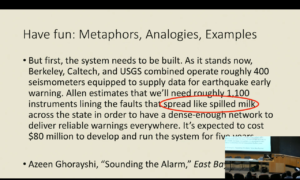Showcase on the Road
Editor’s Note: One of our hopes for Showcase is that it will be used as a tool in the classroom and in discussions of science journalism. Here, freelance science writer Amber Dance explains how she used Showcase to help guide a talk at Brown University.
Would I like a paid trip back to my undergraduate alma mater to talk about science writing at a symposium? asked the email. Why, of course I would!
I’ve talked about my career transition — from scientist to science writer — at many events in the past. I’ve got that presentation down pat. But at the symposium, titled “Communicating Science to Society,” the organizers were also eager for me to present strategies for translating research findings to a lay audience in an engaging way.
I do the latter all the time (at least I attempt to), but this would be my first try at teaching others how it’s done. Immediately, I knew that I wanted to impart a few basic concepts, like starting with an attention-grabbing lede or news peg and then moving on into a nut graf, metaphors, and active language.
But as my high school English teachers used to say, “Show, don’t tell.” I didn’t want to simply say, “Go forth and write an appealing lede that will make the reader want to keep going.” I wanted to show examples of these key concepts.
And that’s where I hit a roadblock. I opened my PowerPoint file and stared at the blank document. Where would I find these stellar examples of ledes, metaphors and the like? (It seemed awfully self-centered to pull them from my own work.)
I supposed I could sift through the four-foot-high stack of magazines in my office corner and find some gems. I did discover a great one by Avi Steinberg while reading the New York Times Magazine. But then, if I had all that time to read, I wouldn’t have a four-foot-high stack of unread magazines, silently guilt-tripping me from that corner.
I also tried Googling “great science lede,” with limited results, although I did come across this fabulous first line by Jenna Fisher in the Christian Science Monitor: “Tom McNichol has fished a lot of strange things out of Boston’s Charles River. Among the most unexpected are a portable toilet, a recliner, and a dead body.”
But I was saved from countless hours of reading or Googling when I remembered talking to Rosalind Reid about CASW’s latest project. Showcase had already collected the text of award-winning science articles, all in one place for me to read. What’s more, their Storygrams had already done the bulk of the work: they’ve annotated them and pointed out evocative descriptions, stellar examples, and clever lines.
Jackpot!
From Cally Carswell’s “The Tree Coroners,” I nabbed a beautiful feature lede, complete with splendid descriptors highlighted by Tom Yulsman: “a mountain riddled with the charred skeletons of fir and pine trees,” “weakened limbs snapped like pretzel sticks” and “ill-kept hedges more than trees, all arms and twisted torsos.”

I grabbed a shorter, but no less effective, descriptor from Azeen Ghorayshi’s “Sounding the Alarm.” In the midst of a numbers-heavy paragraph, Ghorayshi describes “the faults that spread like spilled milk” across California. The simile “gives the reader a break from the necessary numbers,” points out annotator Ann Finkbeiner.
I also wanted to let the students know they could have some fun with the writing beyond the lede, including anecdotes, examples, or analogies that would have no place in their more staid, academic-style papers.
I found my example in Matthew Miller’s “Battle of the Ash Borer.” In an article discussing how scientists are trying to keep a pest under control, he offers a delightful aside in a Native American tale about the origin of the black ash tree: “Near the end of his life, the story goes, Black Elk asked the creator for a way to help his people. He was given a vision. His people were to watch over the tree that would sprout from his buried ashes, to hold it sacred.”
Plus, I think it’s important for readers to hear about people, not just research. For that, I referenced Alexandra Witze’s “The 24.7 Search for Killer Quakes.” She could’ve opened with the earth rumbling, but instead, she starts with characters: the seismologists making their first measurements of a tremendous temblor in Asia.
From wondering which examples to use, I suddenly had all I needed. And the talk went well, I think — watch it here if you’re interested.
| Amber Dance is a freelance science writer in Los Angeles. In 2010, she received the Evert Clark/Seth Payne Award for young science journalists. She co-chairs NASW’s Science in Society awards committee, and recently blogged for “The Envelope, Please” about how NOT to enter a writing competition. |

